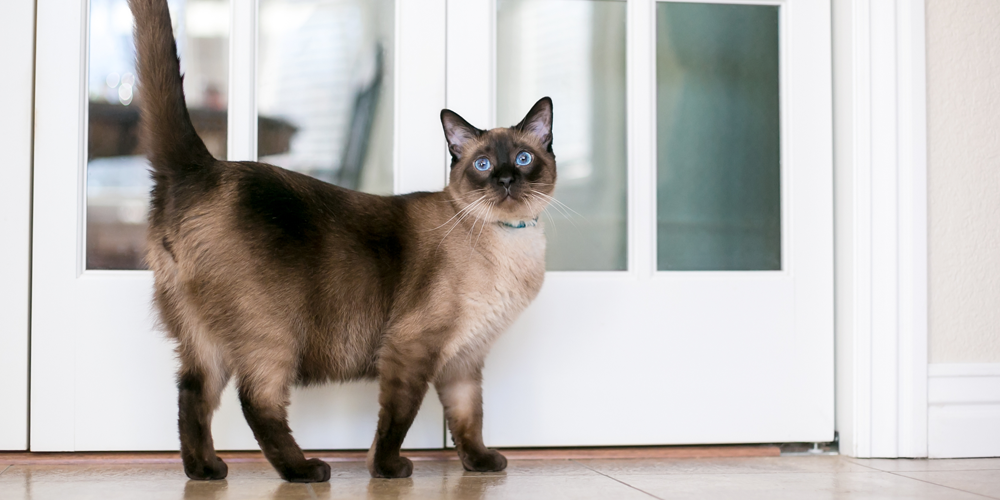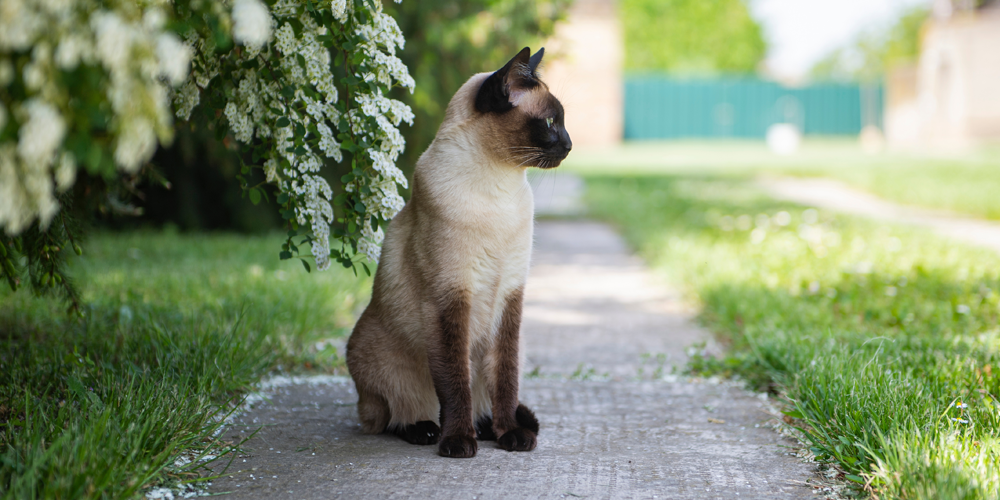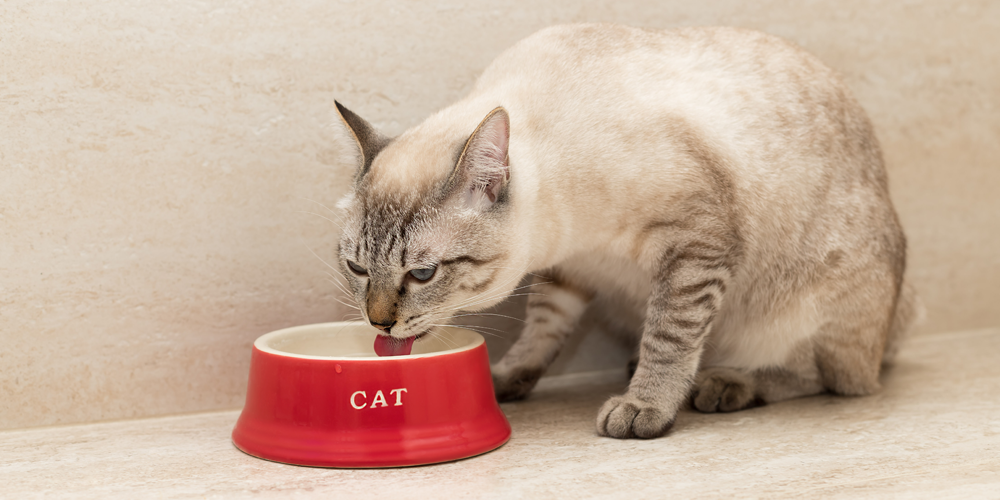By Dr. Natalie L. Marks, DVM, CVJ, CCFP, FFCP-Elite
Like humans, many diseases arise in cats when they reach middle age. This applies to diseases like diabetes mellitus, chronic kidney disease, and the syndrome discussed here: hyperthyroidism. This disease is caused by an overproduction of two thyroid hormones (T3 and T4) from an enlarged thyroid gland in your cat’s neck. Normal thyroid hormone levels regulate temperature, metabolism, and many other functions. When levels are excessive, however, they can create secondary complications for your cat, including heart disease, high blood pressure (hypertension), and retinal bleeding or detachment, a cause of sudden blindness.

What Causes an Overactive Thyroid?
The cause of feline hyperthyroidism is still unknown. However, three known factors contribute to this disease. In most cases, affected cats have developed a non-cancerous tumor of the thyroid gland called an adenoma. While it is a benign tumor, it is still functional, and too much thyroid hormone is produced. In less than 2% of cases, cats develop a malignant or cancerous tumor called a thyroid adenocarcinoma. Additionally, two other factors for consideration include deficiencies in certain parts of their diet (mainly iodine) or chronic exposure to thyroid-disrupting chemicals in the food or environment.
Is My Cat at Risk?
This disease is most common in older cats, with the average age being about 12 years old. It’s very uncommon to see cats younger than 10 develop this disease. While no breeds are at higher risk, some breeds, such as Siamese, Burmese, Persian, Abyssinian, Tonkinese, and British shorthairs, are seen less with this disease.

Signs of Hyperthyroidism
Just like with chronic kidney disease in cats, the earliest stages of the disease are often missed because signs are subtle. But thyroid hormone can affect almost every organ in the body, so cats can show many clinical signs as the disease progresses. The most common are weight loss, vomiting, diarrhea, increased thirst, and urination. They also have some distinct behavioral changes – they’re often restless, seem grumpy, or even become aggressive. Hyperthyroid cats will often be more vocal, especially at night. Another place to look is your cat’s coat quality – many hyperthyroid cats have unkempt, matted, or greasy coats. As this disease progresses, cats will develop anorexia (a complete loss of appetite).

The Hyperthyroid Diagnosis
If you’ve noticed any of these changes, the next step is an exam with your veterinarian. While performing a complete physical exam, we will spend extra time feeling your cat’s neck to check for an enlarged thyroid gland. We might also hear a significantly elevated heart rate or even an abnormal heart rhythm, both often associated with untreated hyperthyroidism.
With the history of signs at home and these exam findings, the next step is to pursue diagnostic testing. Typically, we start with a blood test and urinalysis, looking for elevations in the total thyroid hormone (TT4.) Other organs, like the kidneys, are often stressed from this elevated hormone level and show enzyme elevations. We need an overall picture of your cat’s health, not just the thyroid gland, to help decide the best treatment option. In a small percentage of cats, we suspect hyperthyroidism based on abnormal signs at home and physical exam findings, but their T4 level in the blood is at the higher end of the normal range. If this happens, we recommend more in-depth thyroid testing to look for early disease in these patients.
Treatment Options
Thankfully, if your cat is diagnosed with hyperthyroidism, you have four treatment options! These include medication, surgery, dietary therapy, and radioactive iodine therapy. Not every cat qualifies for every treatment; like most things, there are advantages and disadvantages. Once diagnosed, your veterinarian will help determine which treatment option(s) are best based on your cat’s overall health status, financial considerations, the results of diagnostic tests, and your ability and willingness to administer daily medications to your cat.
Medication
Anti-thyroid medication (methimazole) works by reducing thyroid hormone production from the thyroid gland, and while it doesn’t cure hyperthyroidism completely, it offers long-term control of the disease. For some cats, medication is a great option – it tends to be easy to obtain, is relatively inexpensive, and comes in both oral and transdermal form (a gel that can rubbed easily onto the inside of the ear flap). However, there are some disadvantages and risks for patients. Medication therapy tends to be lifelong, typically twice daily, and some patients are difficult to medicate consistently. Additionally, there are numerous possible side effects, including vomiting, anorexia, anemia, liver damage, lethargy, a decrease in white blood cells, and a decrease in blood platelets. If low platelets develop, it can cause difficulty clotting and excessive bleeding. Regular recheck exams and blood work are required every three to six months to monitor treatment and look for any possible complications like changes in kidney function.
In some instances, this therapy is used temporarily to help stabilize cats headed to surgery or to see if they qualify for radioactive iodine therapy in the coming weeks.
Surgery
Surgery used to be one of the few options we had to provide a straightforward and permanent cure for this disease. But while surgical removal of the thyroid glands (surgical thyroidectomy) is still an option for cats, it’s pursued much less often because of the possible risks associated with the surgery. One of the significant risks associated with surgery is unintentional damage or removal of the parathyroid glands located close to the thyroid glands. They are responsible for maintaining stable calcium levels in the blood, and their absence can create low calcium and life-threatening complications. This surgery also requires general anesthesia, and there can be added risk when patients have other diseases involving the heart or kidneys.
Dietary Therapy
There is a smaller group of cats where these other treatment options are not recommended or possible. Thankfully, for those patients, there is hope. Over a decade of research demonstrated that when we limit how much iodine a cat consumes, a hyperthyroid cat will return to normal thyroid production. When this diet is strictly given without any treats, it can resolve clinical signs and be successful. However, this option should be discussed thoroughly with your veterinarian to ensure it’s the best choice and that your cat qualifies for this therapy.

Radioactive Iodine Therapy (I-131)
Although this is the last option listed, it’s widely considered the treatment of choice for cats with hyperthyroidism. When most clients hear the name of this treatment, it’s often accompanied by apprehension or even fear. However, the treatment is relatively straightforward. Radioactive iodine is given to the patient through an injection, goes into the blood, and then is absorbed by the thyroid gland. This targeted radiation destroys only the abnormal thyroid tissue in the gland. Most cats’ thyroid hormone levels normalize within 1-2 weeks of treatment.
This treatment is attractive to many families because of the single injection and long-term success. The Cornell University Feline Health Center reports that radioactive iodine therapy is curative for approximately 95% of all hyperthyroid cats within three months of treatment. That’s a tremendous success rate. However, due to the handling and use of a radioactive substance, this therapy is only administered in specialized facilities that have achieved certification and licensing to handle radiation. While protective measures must be taken for all people who come in close contact with the patient, radioactive iodine is not a risk for the cat. The treated cat must stay in the specialty center until radiation levels have fallen to an acceptable level, typically 3-5 days. The other potential risk is when a patient’s thyroid levels fall too low after therapy, a syndrome called hypothyroidism. These cats start to become more lethargic and gain weight and must receive thyroid hormone supplementation indefinitely. While this risk is rare, it is possible and one to discuss before therapy.
What About Prognosis?
While we don’t know how to prevent hyperthyroidism in cats, the next best strategy is early detection. If you have a middle-aged or senior cat, ensure you see your veterinarian every six months, even if your cat appears normal at home. Annual blood and urine screening tests are beneficial to support a routine physical exam. The earlier we can diagnose hyperthyroidism, the better the prognosis!
About Dr. Natalie L. Marks, DVM, CVJ, CCFP, FFCP-Elite
Dr. Natalie Marks is an internationally renowned veterinarian and educational consultant with over 20 years of experience as a practicing veterinarian. Dr. Marks is dedicated to helping pet owners and veterinarians work together as a team to provide the best care for their pets’ health and wellbeing. In 1998, she graduated with her bachelor’s degree in Animal Science from the University of Illinois before going on to obtain her Master’s and Doctorate in Veterinary Medicine from the University of Illinois College of Veterinary Medicine. Dr. Marks’ dedication to the field of veterinary medicine has earned her numerous awards and accolades, including the Dr. Erwin Small First Decade Award, Petplan’s Veterinary of the Year in 2012, and America’s Favorite Veterinarian from the American Veterinary Medical Foundation in 2015. In addition to being a familiar face on both local and national media outlets, Dr. Marks has been a lecturer on a variety of topics at conferences like VMX, WVC, and AVMA.

Share this Quiz